Science
Explosion of power-hungry data centers could derail California clean energy goals
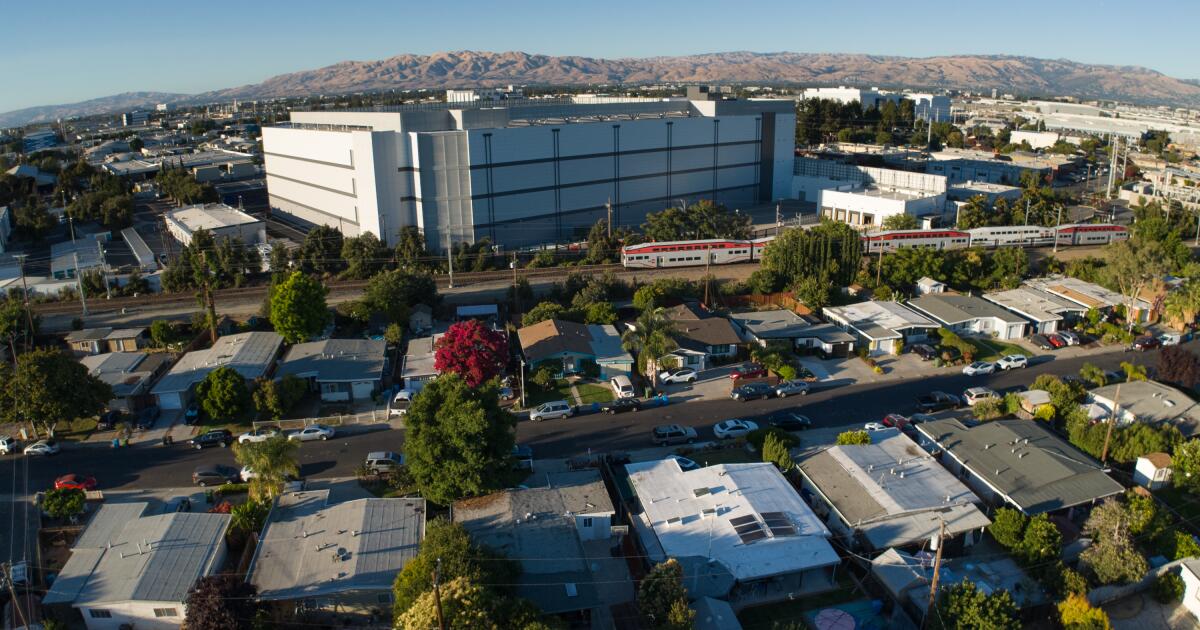
Near the Salton Sea, a company plans to build a data center to support artificial intelligence that would cover land the size of 15 football fields and require power that could support 425,000 homes.
In Santa Clara — the heart of Silicon Valley — electric rates are rising as the municipal utility spends heavily on transmission lines and other infrastructure to accommodate the voracious power demand from more than 50 data centers, which now consume 60% of the city’s electricity.
And earlier this year, Pacific Gas & Electric told investors that its customers have proposed more than two dozen data centers, requiring 3.5 gigawatts of power — the output of three new nuclear reactors.
Vantage Data Center in Santa Clara is equipped with its own electrical substations.
(Paul Kuroda / For The Times)
While the benefits and risks of AI continue to be debated, one thing is clear: The technology is rapacious for power. Experts warn that the frenzy of data center construction could delay California’s transition away from fossil fuels and raise electric bills for everyone else. The data centers’ insatiable appetite for electricity, they say, also increases the risk of blackouts.
Even now, California is at the verge of not having enough power. An analysis of public data by the nonprofit GridClue ranks California 49th of the 50 states in resilience — or the ability to avoid blackouts by having more electricity available than homes and businesses need at peak hours.
“California is working itself into a precarious position,” said Thomas Popik, president of the Foundation for Resilient Societies, which created GridClue to educate the public on threats posed by increasing power use.
The state has already extended the lives of Pacific Gas & Electric Co.’s Diablo Canyon nuclear plant as well as some natural gas-fueled plants in an attempt to avoid blackouts on sweltering days when power use surges.
Worried that California could no longer predict its need for power because of fast-rising use, an association of locally run electricity providers called on state officials in May to immediately analyze how quickly demand was increasing.
The California Community Choice Assn. sent its letter to the state energy commission after officials had to revise their annual forecast of power demand upward because of skyrocketing use by Santa Clara’s dozens of data centers.
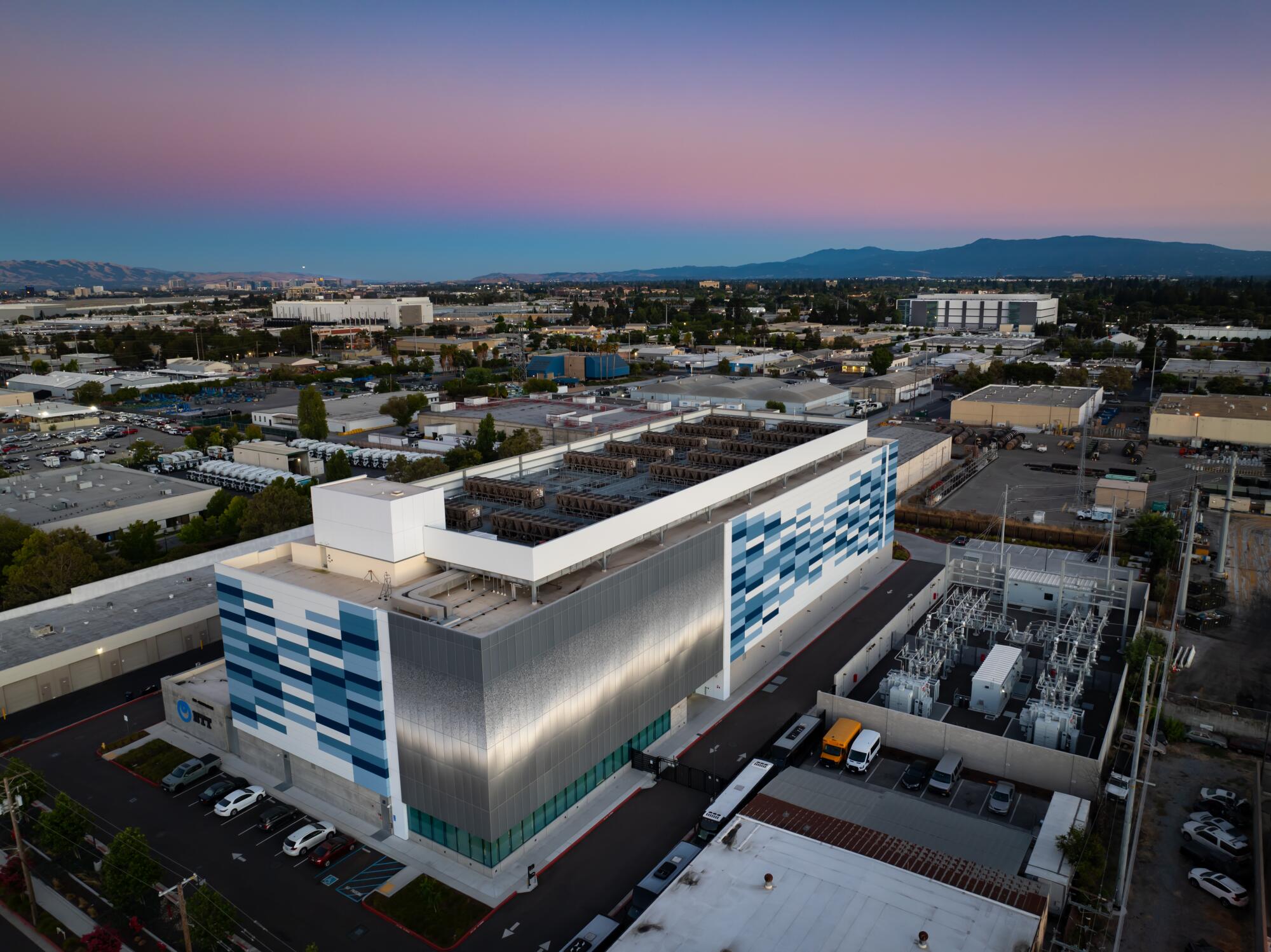
A large NTT data center rises in a Santa Clara neighborhood.
(Paul Kuroda / For The Times)
The facilities, giant warehouses of computer servers, have long been big power users. They support all that Americans do on the internet — from online shopping to streaming Netflix to watching influencers on TikTok.
But the specialized chips required for generative AI use far more electricity — and water — than those that support the typical internet search because they are designed to read through vast amounts of data.
A ChatGPT-powered search, according to the International Energy Agency, consumes 10 times the power as a search on Google without AI.
And because those new chips generate so much heat, more power and water is required to keep them cool.
“I’m just surprised that the state isn’t tracking this, with so much attention on power and water use here in California,” said Shaolei Ren, associate professor of electrical and computer engineering at UC Riverside.
Ren and his colleagues calculated that the global use of AI could require as much fresh water in 2027 as that now used by four to six countries the size of Denmark.
Driving the data center construction is money. Today’s stock market rewards companies that say they are investing in AI. Electric utilities profit as power use rises. And local governments benefit from the property taxes paid by data centers.

Transmission lines are reflected on the side of the NTT data center in Santa Clara.
(Paul Kuroda / For The Times)
Silicon Valley is the world’s epicenter of AI, with some of the biggest developers headquartered there, including Alphabet, Apple and Meta. OpenAI, the creator of ChatGPT, is based in San Francisco. Nvidia, the maker of chips needed for AI, operates from Santa Clara.
The big tech companies leading in AI, which also include Microsoft and Amazon, are spending billions to build new data centers around the world. They are also paying to rent space for their servers in so-called co-location data centers built by other companies.
In a Chicago suburb, a developer recently bought 55 homes so they could be razed to build a sprawling data center campus.
Energy officials in northern Virginia, which has more data centers than any other region in the world, have proposed a transmission line to shore up the grid that would depend on coal plants that had been expected to be shuttered.
In Oregon, Google and the city of The Dalles fought for 13 months to prevent the Oregonian from getting records of how much water the company’s data centers were consuming. The newspaper won the court case, learning the facilities drank up 29% of the city’s water.
By 2030, data centers could account for as much as 11% of U.S. power demand — up from 3% now, according to analysts at Goldman Sachs.
“We must demand more efficient data centers or else their continued growth will place an unsustainable strain on energy resources, impact new home building, and increase both carbon emissions and California residents’ cost of electricity,” wrote Charles Giancarlo, chief executive of the Santa Clara IT firm Pure Storage.
Santa Clara a top market for data centers
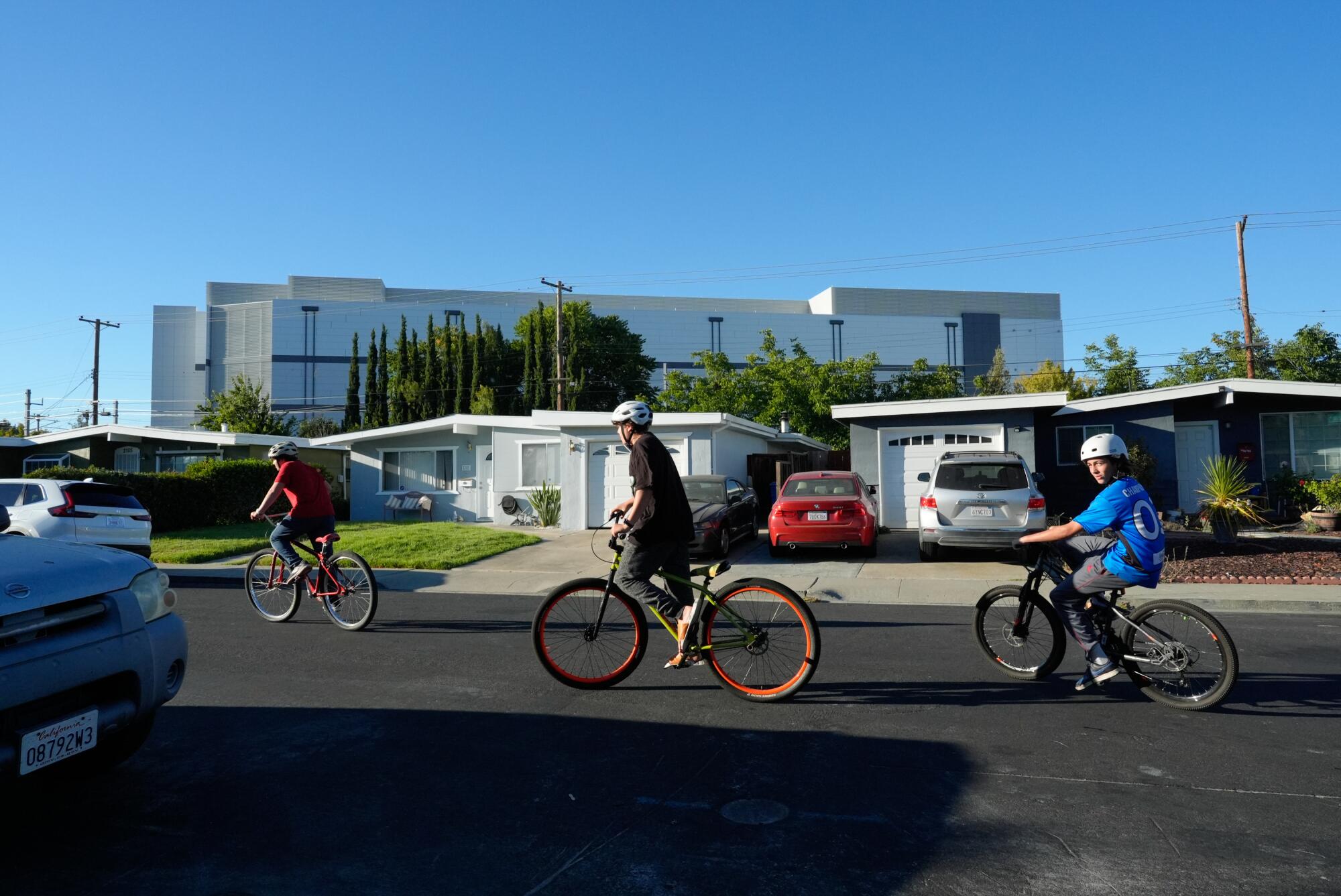
Boys ride their bikes on Main Street near a large data center in Santa Clara.
(Paul Kuroda / For The Times)
California has more than 270 data centers, with the biggest concentration in Santa Clara. The city is an attractive location because its electric rates are 40% lower than those charged by PG&E.
But the lower rates come with a higher cost to the climate. The city’s utility, Silicon Valley Power, emits more greenhouse gas than the average California electric utility because 23% of its power for commercial customers comes from gas-fired plants. Another 35% is purchased on the open market where the electricity’s origin can’t be traced.
The utility also gives data centers and other big industrial customers a discount on electric rates.
While Santa Clara households pay more for each kilowatt hour beyond a certain threshold, the rate for data centers declines as they use more power.
The city receives millions of dollars of property taxes from the data centers. And 5% of the utility’s revenue goes to the city’s general fund, where it pays for services such as road maintenance and police.
An analysis last year by the Silicon Valley Voice newspaper questioned the lower rates data centers pay compared with residents.
“What impetus do Santa Clarans have to foot the bill for these environmentally unfriendly behemoth buildings?” wrote managing editor Erika Towne.
In October, Manuel Pineda, the utility’s top official, told the City Council that his team was working to double power delivery over the next 10 years. “We prioritize growth as a strategic opportunity,” he said.
He said usage by data centers was continuing to escalate, but the utility was nearing its power limit. He said 13 new data centers were under construction and 12 more were moving forward with plans.
“We cannot currently serve all data centers that would like to be in Santa Clara,” he said.
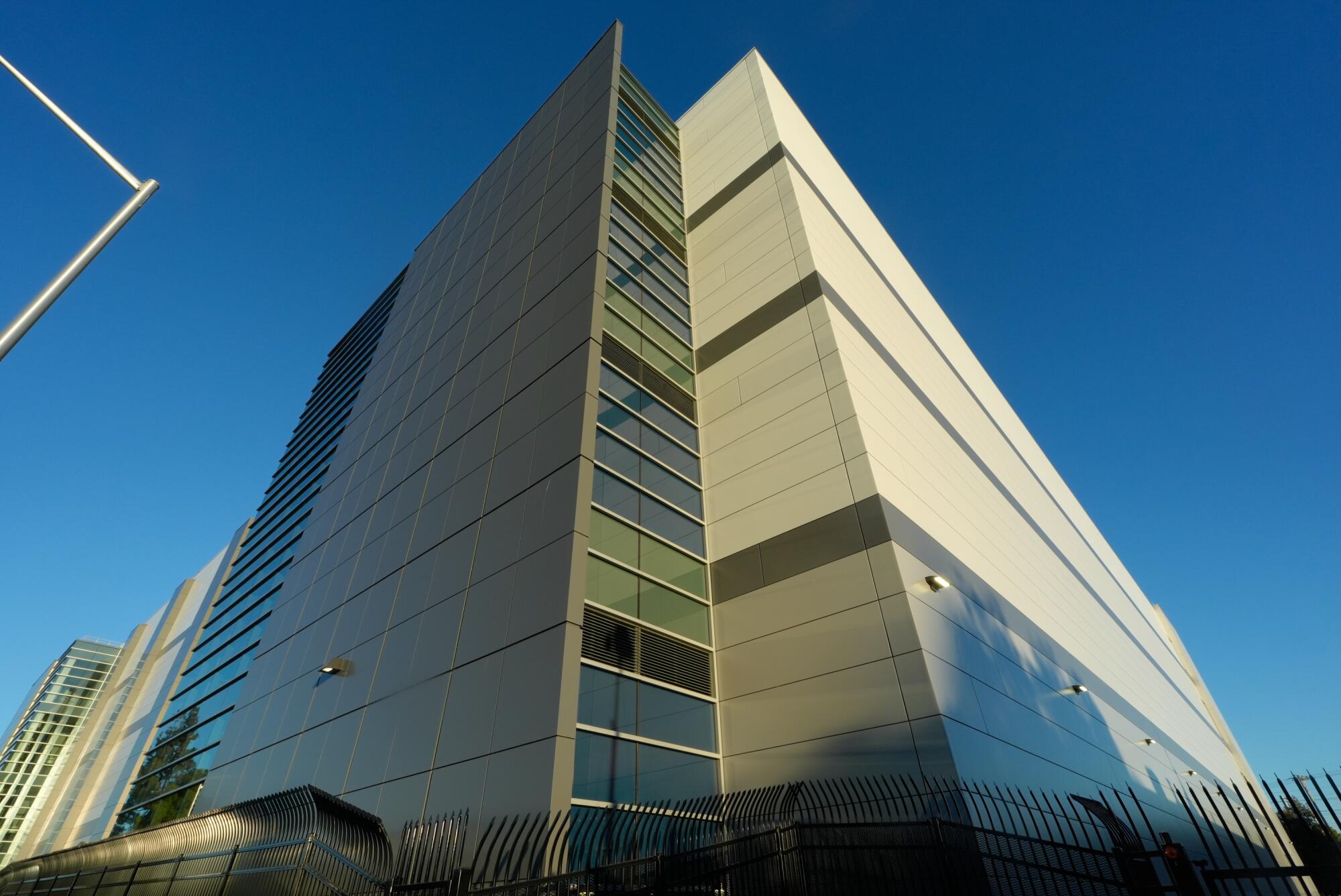
Dozens of data centers have been built for artificial intelligence and the internet in Santa Clara.
(Paul Kuroda / For The Times)
To accommodate increasing power use, the city is now spending heavily on transmission lines, substations and other infrastructure. At the same time, electric rates are rising. Rates had been increasing by 2% to 3% a year, but they jumped by 8% in January 2023, another 5% in July 2023 and 10% last January.
Pineda told The Times that it wasn’t just the new infrastructure that pushed rates up. The biggest factor, he said, was a spike in natural gas prices in 2022, which increased power costs.
He said residential customers pay higher rates because the distribution system to homes requires more poles, wires and transformers than the system serving data centers, which increases maintenance costs.
Pineda said the city’s decisions to approve new data centers “are generally based on land use factors, not on revenue generation.”
Loretta Lynch, former chair of the state’s public utilities commission, noted that big commercial customers such as data centers pay lower rates for electricity across the state. That means when transmission lines and other infrastructure must be built to handle the increasing power needs, residential customers pick up more of the bill.
“Why aren’t data centers paying their fair share for infrastructure? That’s my question,” she said.
PG&E eyes profits from boom
The grid’s limited capacity has not stopped PG&E from wooing companies that want to build data centers.
“I think we will definitely be one of the big ancillary winners of the demand growth for data centers,” Patricia Poppe, PG&E’s chief executive, told Wall Street analysts on an April conference call.
Poppe said she recently invited the company’s tech customers to an event at a San José substation.
“When I got there, I was pleasantly surprised to see AWS, Microsoft, Apple, Google, Equinix, Cisco, Western Digital Semiconductors, Tesla, all in attendance. These are our customers that we serve who want us to serve more,” she said on the call. “They were very clear: they would build … if we can provide.”
In June, PG&E revealed it had received 26 applications for new data centers, including three that need at least 500 megawatts of power, 24 hours a day. In all, the proposed data centers would use 3.5 gigawatts. That amount of power could support nearly 5 million homes, based on the average usage of a California household of 6,174 kilowatts a year.
In the June presentation, PG&E said the new data centers would require it to spend billions of dollars on new infrastructure.
Already PG&E can’t keep up with connecting customers to the grid. It has fallen so far behind on connecting new housing developments that last year legislators passed a law to try to shorten the delays. At that time, the company told Politico that the delays stemmed from rising electricity demand, including from data centers.
In a statement to The Times, PG&E said its system was “ready for data centers.”
The company said its analysis showed that adding the data centers would not increase bills for other customers.
Most of the year, excluding extreme hot weather, its grid “is only 45% utilized on average,” the company said.
“Data centers’ baseload will enable us to utilize more of this percentage and deliver more per customer dollar,” the company said. “For every 1,000 MW load from data centers we anticipate our customers could expect 1-2% saving on their monthly electricity bill.”
The company added that it was “developing tools to ensure that every customer can cost-effectively connect new loads to the system with minimal delay.”
Lynch questioned the company’s analysis that adding data centers could reduce bills for other customers. She pointed out that utilities earn profits by investing in new infrastructure. That’s because they get to recover that cost — plus an annual rate of return — through rates billed to all customers.
“The more they spend, the more they make,” she said.
In the desert, cheap land and green energy
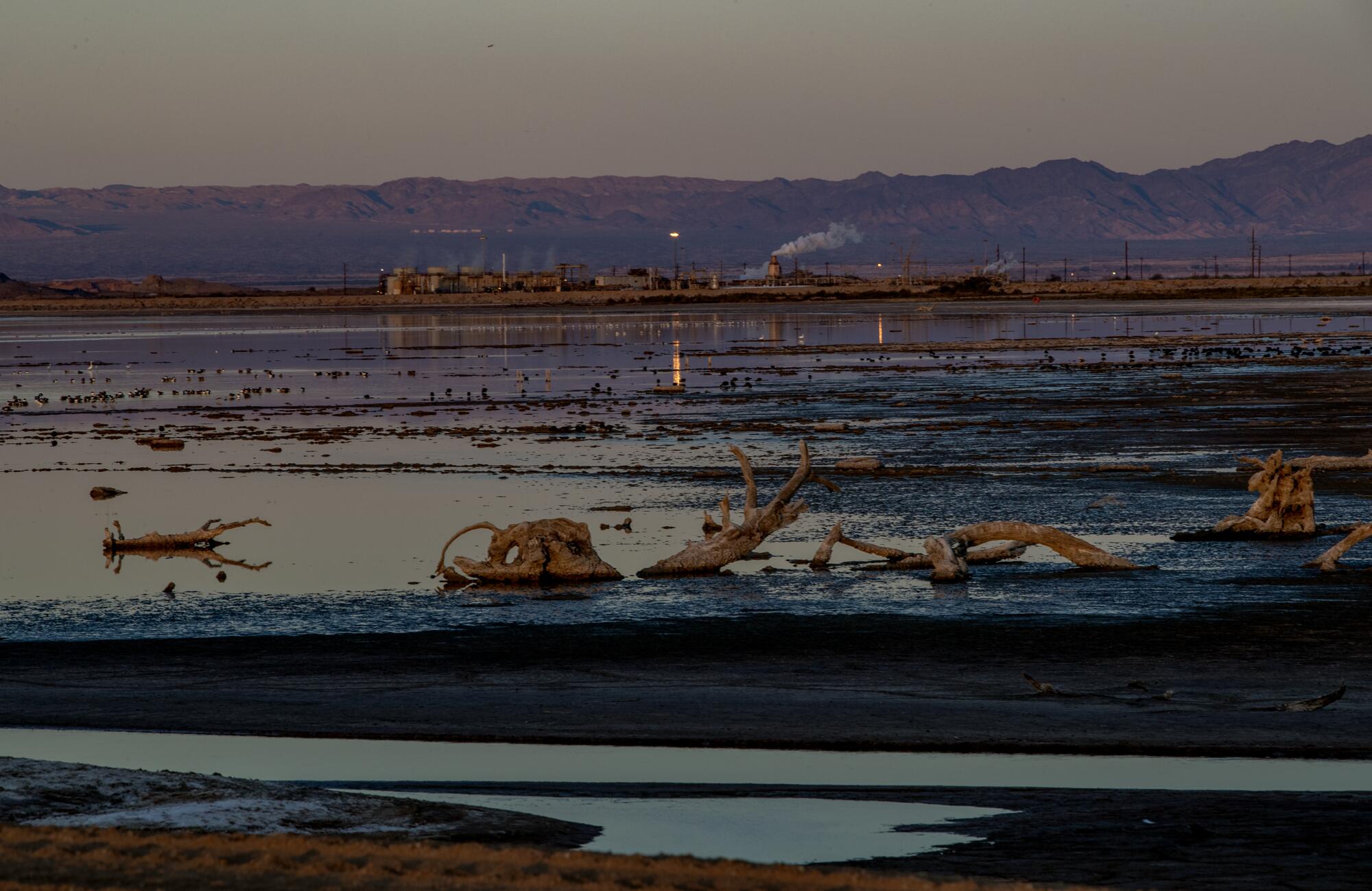
A geothermal plant viewed from across the Salton Sea in December 2022.
(Gina Ferazzi / Los Angeles Times)
The power and land constraints in Santa Clara and other cities have data center developers looking for new frontiers.
“On the edge of the Southern California desert in Imperial County sits an abundance of land,” begins the sales brochure for the data center that a company called CalEthos is building near the south shore of the Salton Sea.
Electricity for the data center’s servers would come from the geothermal and solar plants built near the site in an area that has become known as Lithium Valley.
The company is negotiating to purchase as much as 500 megawatts of power, the brochure said.
Water for the project would come from the state’s much fought over allotment from the Colorado River.
Imperial County is one of California’s poorest counties. More than 80% of its population are Latino. Many residents are farmworkers.
Executives from Tustin-based CalEthos told The Times that by using power from the nearby geothermal plants it would help the local community.
“By creating demand for local energy, CalEthos will help accelerate the development of Lithium Valley and its associated economic benefits,” Joel Stone, the company’s president, wrote in an email.
“We recognize the importance of responsible energy and water use in California,” Stone said. “Our data centers will be designed to be as efficient as possible.”
For example, Stone said that in order to minimize water use, CalEthos plans a cooling system where water is recirculated and “requires minimal replenishment due to evaporation.”
Already, a local community group, Comite Civico del Valle, has raised concerns about the environmental and health risks of one of the nearby geothermal plants that plans to produce lithium from the brine brought up in the energy production process.
One of the group’s concerns about the geothermal plant is that its water use will leave less to replenish the Salton Sea. The lake has been decreasing in size, creating a larger dry shoreline that is laden with bacteria and chemicals left from decades of agricultural runoff. Scientists have tied the high rate of childhood asthma in the area to dust from the shrinking lake’s shores.
James Blair, associate professor of geography and anthropology at Cal Poly Pomona, questioned whether the area was the right place for a mammoth data center.
“Data centers drain massive volumes of energy and water for chillers and cooling towers to prevent servers from overheating,” he said.
Blair said that while the company can tell customers its data center is supported by environmentally friendly solar and geothermal power, it will take that renewable energy away from the rest of California’s grid, making it harder for the state to meet its climate goals.

Science
California’s last nuclear plant clears major hurdle to power on

California environmental regulators on Thursday struck a landmark deal with Pacific Gas & Electric to extend the life of the state’s last remaining nuclear power plant in exchange for thousands of acres of new land conservation in San Luis Obispo County.
PG&E’s agreement with the California Coastal Commission is a key hurdle for the Diablo Canyon nuclear plant to remain online until at least 2030. The plant was slated to close this year, largely due to concerns over seismic safety, but state officials pushed to delay it — saying the plant remains essential for the reliable operation of California’s electrical grid. Diablo Canyon provides nearly 9% of the electricity generated in the state, making it the state’s single largest source.
The Coastal Commission voted 9-3 to approve the plan, settling the fate of some 12,000 acres that surround the power plant as a means of compensation for environmental harm caused by its continued operation.
Nuclear power does not emit greenhouse gases. But Diablo Canyon uses an estimated 2.5 billion gallons of ocean water each day to absorb heat in a process known as “once-through cooling,” which kills an estimated two billion or more marine organisms each year.
Some stakeholders in the region celebrated the conservation deal, while others were disappointed by the decision to trade land for marine impacts — including a Native tribe that had hoped the land would be returned to them. Diablo Canyon sits along one of the most rugged and ecologically rich stretches of the California coast.
Under the agreement, PG&E will immediately transfer a 4,500-acre parcel on the north side of the property known as the “North Ranch” into a conservation easement and pursue transfer of its ownership to a public agency such as the California Department of Parks and Recreation, a nonprofit land conservation organization or tribe. A purchase by State Parks would result in a more than 50% expansion of the existing Montaña de Oro State Park.
PG&E will also offer a 2,200-acre parcel on the southern part of the property known as “Wild Cherry Canyon” for purchase by a government agency, nonprofit land conservation organization or tribe. In addition, the utility will provide $10 million to plan and manage roughly 25 miles of new public access trails across the entire property.
“It’s going to be something that changes lives on the Central Coast in perpetuity,” Commissioner Christopher Lopez said at the meeting. “This matters to generations that have yet to exist on this planet … this is going to be a place that so many people mark in their minds as a place that transforms their lives as they visit and recreate and love it in a way most of us can’t even imagine today.”
Critically, the plan could see Diablo Canyon remain operational much longer than the five years dictated by Thursday’s agreement. While the state Legislature only authorized the plant to operate through 2030, PG&E’s federal license renewal would cover 20 years of operations, potentially keeping it online until 2045.
Should that happen, the utility would need to make additional land concessions, including expanding an existing conservation area on the southern part of the property known as the “South Ranch” to 2,500 acres. The plan also includes rights of first refusal for a government agency or a land conservation group to purchase the entirety of the South Ranch, 5,000 acres, along with Wild Cherry Canyon — after 2030.

Pelicans along the concrete breakwater at Pacific Gas and Electric’s Diablo Canyon Power Plant
(Brian van der Brug/Los Angeles Times)
Many stakeholders were frustrated by the carve-out for the South Ranch, but still saw the agreement as an overall victory for Californians.
“It is a once in a lifetime opportunity,” Sen. John Laird (D-Santa Cruz) said in a phone call ahead of Thursday’s vote. “I have not been out there where it has not been breathtakingly beautiful, where it is not this incredible, unique location, where you’re not seeing, for much of it, a human structure anywhere. It is just one of those last unique opportunities to protect very special land near the California coast.”
Others, however, described the deal as disappointing and inadequate.
That includes many of the region’s Native Americans who said they felt sidelined by the agreement. The deal does not preclude tribal groups from purchasing the land in the future, but it doesn’t guarantee that or give them priority.
The yak titʸu titʸu yak tiłhini Northern Chumash Tribe of San Luis Obispo County and Region, which met with the Coastal Commission several times in the lead-up to Thursday’s vote, had hoped to see the land returned to them.
Scott Lanthrop is a member of the tribe’s board and has worked on the issue for several years.
“The sad part is our group is not being recognized as the ultimate conservationist,” he told The Times. “Any normal person, if you ask the question, would you rather have a tribal group that is totally connected to earth and wind and water, or would you like to have some state agency or gigantic NGO manage this land, I think the answer would be, ‘Hey, you probably should give it back to the tribe.’”
Tribe chair Mona Tucker said she fears that free public access to the land could end up harming it instead of helping it, as the Coastal Commission intends.
“In my mind, I’m not understanding how taking the land … is mitigation for marine life,” Tucker said. “It doesn’t change anything as far as impacts to the water. It changes a lot as far as impacts to the land.”

Montaña de Oro State Park.
(Christopher Reynolds / Los Angeles Times)
The deal has been complicated by jurisdictional questions, including who can determine what happens to the land. While PG&E owns the North Ranch parcel that could be transferred to State Parks, the South Ranch and Wild Cherry Canyon are owned by its subsidiary, Eureka Energy Company.
What’s more, the California Public Utilities Commission, which regulates utilities such as PG&E, has a Tribal Land Transfer Policy that calls for investor-owned power companies to transfer land they no longer want to Native American tribes.
In the case of Diablo Canyon, the Coastal Commission became the decision maker because it has the job of compensating for environmental harm from the facility’s continued operation. Since the commission determined Diablo’s use of ocean water can’t be avoided, it looked at land conservation as the next best method.
This “out-of-kind” trade-off is a rare, but not unheard of way of making up for the loss of marine life. It’s an approach that is “feasible and more likely to succeed” than several other methods considered, according to the commission’s staff report.
“This plan supports the continued operation of a major source of reliable electricity for California, and is in alignment with our state’s clean energy goals and focus on coastal protection,” Paula Gerfen, Diablo Canyon’s senior vice president and chief nuclear officer, said in a statement.
But Assemblymember Dawn Addis (D-Morro Bay) said the deal was “not the best we can do” — particularly because the fate of the South Ranch now depends on the plant staying in operation beyond 2030.
“I believe the time really is now for the immediate full conservation of the 12,000 [acres], and to bring accountability and trust back for the voters of San Luis Obispo County,” Addis said during the meeting.
There are also concerns about the safety of continuing to operate a nuclear plant in California, with its radioactive waste stored in concrete casks on the site. Diablo Canyon is subject to ground shaking and earthquake hazards, including from the nearby Hosgri Fault and the Shorline Fault, about 2.5 miles and 1 mile from the facility, respectively.
PG&E says the plant has been built to withstand hazards. It completed a seismic hazard assessment in 2024, and determined Diablo Canyon is safe to continue operation through 2030. The Coastal Commission, however, found if the plant operates longer, it would warrant further seismic study.
A key development for continuing Diablo Canyon’s operation came in 2022 with Senate Bill 846, which delayed closure by up to five additional years. At the time, California was plagued by rolling blackouts driven extreme heat waves, and state officials were growing wary about taking such a major source of power offline.
But California has made great gains in the last several years — including massive investments in solar energy and battery storage — and some questioned whether the facility is still needed at all.
Others said conserving thousands of acres of land still won’t make up for the harms to the ocean.
“It is unmitigatable,” said David Weisman, executive director of the nonprofit Alliance for Nuclear Responsibility. He noted that the Coastal Commission’s staff report says it would take about 99 years to balance the loss of marine life with the benefits provided by 4,500 acres of land conservation. Twenty more years of operation would take about 305 years to strike that same balance.
But some pointed out that neither the commission nor fisheries data find Diablo’s operations cause declines in marine life. Ocean harm may be overestimated, said Seaver Wang, an oceanographer and the climate and energy director at the Breakthrough Institute, a Berkeley-based research center.
In California’s push to transition to clean energy, every option comes with downsides, Wang said. In the case of nuclear power — which produces no greenhouse gas emissions — it’s all part of the trade off, he said.
“There’s no such thing as impacts-free energy,” he said.
The Coastal Commission’s vote is one of the last remaining obstacles to keeping the plant online. PG&E will also need a final nod from the Regional Water Quality Control Board, which decides on a pollution discharge permit in February.
The federal Nuclear Regulatory Commission will also have to sign off on Diablo’s extension.
Science
In search for autism’s causes, look at genes, not vaccines, researchers say

Earlier this year, Health and Human Services Secretary Robert F. Kennedy Jr. pledged that the search for autism’s cause — a question that has kept researchers busy for the better part of six decades — would be over in just five months.
“By September, we will know what has caused the autism epidemic, and we’ll be able to eliminate those exposures,” Kennedy told President Trump during a Cabinet meeting in April.
That ambitious deadline has come and gone. But researchers and advocates say that Kennedy’s continued fixation on autism’s origins — and his frequent, inaccurate claims that childhood vaccines are somehow involved — is built on fundamental misunderstandings of the complex neurodevelopmental condition.
Even after more than half a century of research, no one yet knows exactly why some people have autistic traits and others do not, or why autism spectrum disorder looks so different across the people who have it. But a few key themes have emerged.
Researchers believe that autism is most likely the result of a complex set of interactions between genes and the environment that unfold while a child is in the womb. It can be passed down through families, or originate with a spontaneous gene mutation.
Environmental influences may indeed play a role in some autism cases, but their effect is heavily influenced by a person’s genes. There is no evidence for a single trigger that causes autism, and certainly not one a child encounters after birth: not a vaccine, a parenting style or a post-circumcision Tylenol.
“The real reason why it’s complicated, the more fundamental one, is that there’s not a single cause,” said Irva Hertz-Picciotto, a professor of public health science and director of the Environmental Health Sciences Center at UC Davis. “It’s not a single cause from one person to the next, and not a single cause within any one person.”
Kennedy, an attorney who has no medical or scientific training, has called research into autism’s genetics a “dead end.” Autism researchers counter that it’s the only logical place to start.
“If we know nothing else, we know that autism is primarily genetic,” said Joe Buxbaum, a molecular neuroscientist who directs the Seaver Autism Center for Research and Treatment at the Icahn School of Medicine at Mount Sinai. “And you don’t have to actually have the exact genes [identified] to know that something is genetic.”
Some neurodevelopment disorders arise from a difference in a single gene or chromosome. People with Down syndrome have an extra copy of chromosome 21, for example, and Fragile X syndrome results when the FMR1 gene isn’t expressed.
Autism in most cases is polygenetic, which means that multiple genes are involved, with each contributing a little bit to the overall picture.
Researchers have found hundreds of genes that could be associated with autism; there may be many more among the roughly 20,000 in the human genome.
In the meantime, the strongest evidence that autism is genetic comes from studies of twins and other sibling groups, Buxbaum and other researchers said.
The rate of autism in the U.S. general population is about 2.8%, according to a study published last year in the journal Pediatrics. Among children with at least one autistic sibling, it’s 20.2% — about seven times higher than the general population, the study found.
Twin studies reinforce the point. Both identical and fraternal twins develop in the same womb and are usually raised in similar circumstances in the same household. The difference is genetic: identical twins share 100% of their genetic information, while fraternal twins share about 50% (the same as nontwin siblings).
If one fraternal twin is autistic, the chance that the other twin is also autistic is about 20%, or about the same as it would be for a nontwin sibling.
But if one in a pair of identical twins is autistic, the chance that the other twin is also autistic is significantly higher. Studies have pegged the identical twin concurrence rate anywhere from 60% to 90%, though the intensity of the twins’ autistic traits may differ significantly.
Molecular genetic studies, which look at the genetic information shared between siblings and other blood relatives, have found similar rates of genetic influence on autism, said Dr. John Constantino, a professor of pediatrics, psychiatry and behavioral sciences at the Emory University School of Medicine and chief of behavioral and mental health at Children’s Healthcare of Atlanta.
Together, he said, “those studies have indicated that a vast share of the causation of autism can be traced to the effects of genetic influences. That is a fact.”
Buxbaum compares the heritability of autism to the heritability of height, another polygenic trait.
“There’s not one gene that’s making you taller or shorter,” Buxbaum said. Hundreds of genes play a role in where you land on the height distribution curve. A lot of those genes run in families — it’s not unusual for very tall people, for example, to have very tall relatives.
But parents pass on a random mix of their genes to their children, and height distribution across a group of same-sex siblings can vary widely. Genetic mutations can change the picture. Marfan syndrome, a condition caused by mutations in the FBN1 gene, typically makes people grow taller than average. Hundreds of genetic mutations are associated with dwarfism, which causes shorter stature.
Then once a child is born, external factors such as malnutrition or disease can affect the likelihood that they reach their full height potential.
So genes are important. But the environment — which in developmental science means pretty much anything that isn’t genetics, including parental age, nutrition, air pollution and viruses — can play a major role in how those genes are expressed.
“Genetics does not operate in a vacuum, and at the same time, the impact of the environment on people is going to depend on a person’s individual genetics,” said Brian K. Lee, a professor of epidemiology and biostatistics at Drexel University who studies the genetics of developmental disorders.
Unlike the childhood circumstances that can affect height, the environmental exposures associated with autism for the most part take place in utero.
Researchers have identified multiple factors linked to increased risks of the disorder, including older parental age, infant prematurity and parental exposure to air pollution and industrial solvents.
Investigations into some of these linkages were among the more than 50 autism-related studies whose funding Kennedy has cut since taking office, a ProPublica investigation found. In contrast, no credible study has found links between vaccines and autism — and there have been many.
One move from the Department of Health and Human Services has been met with cautious optimism: even as Kennedy slashed funding to other research projects, the department in September announced a $50-million initiative to explore the interactions of genes and environmental factors in autism, which has been divided among 13 different research groups at U.S. universities, including UCLA and UC San Diego.
The department’s selection of well-established, legitimate research teams was met with relief by many autism scientists.
But many say they fear that such decisions will be an anomaly under Kennedy, who has repeatedly rejected facts that don’t conform to his preferred hypotheses, elevated shoddy science and muddied public health messaging on autism with inaccurate information.
Disagreements are an essential part of scientific inquiry. But the productive ones take place in a universe of shared facts and build on established evidence.
And when determining how to spend limited resources, researchers say, making evidence-based decisions is vital.
“There are two aspects of these decisions: Is it a reasonable expenditure based on what we already know? And if you spend money here, will you be taking money away from HHS that people are in desperate need of?” Constantino said. “If you’re going to be spending money, you want to do that in a way that is not discarding what we already know.”
Science
Contributor: New mothers are tempted by Ozempic but don’t have the data they need

My friend Sara, eight weeks after giving birth, left me a tearful voicemail. I’m a clinical psychologist specializing in postpartum depression and psychosis, but mental health wasn’t Sara’s issue. Postpartum weight gain was.
Sara told me she needed help. She’d gained 40 pounds during her pregnancy, and she was still 25 pounds overweight. “I’m going back to work and I can’t look like this,” she said. “I need to take Ozempic or something. But do you know if it’s safe?”
Great question. Unfortunately researchers don’t yet have an answer. On Dec. 1, the World Health Organization released its first guidelines on the use of GLP-1 receptor agonists such as Ozempic, generically known as semaglutide. One of the notable policy suggestions in that report is to not prescribe GLP-1s to pregnant women. Disappointingly, the report says nothing about the use of the drug by postpartum women, including those who are breastfeeding.
There was a recent Danish study that led to medical guidelines against prescribing to patients who are pregnant or breastfeeding.
None of that is what my friend wanted to hear. I could only encourage her to speak to her own medical doctor.
Sara’s not alone. I’ve seen a trend emerging in my practice in which women use GLP-1s to shed postpartum weight. The warp speed “bounce-back” ideal of body shapes for new mothers has reemerged, despite the mental health field’s advocacy to abolish the archaic pressure of martyrdom in motherhood. GLP-1s are being sold and distributed by compound pharmacies like candy. And judging by their popularity, nothing tastes sweeter than skinny feels.
New motherhood can be a stressful time for bodies and minds, but nature has also set us up for incredible growth at that moment. Contrary to the myth of spaced-out “mommy brains,” new neuroplasticity research shows that maternal brains are rewired for immense creativity and problem solving.
How could GLP-1s affect that dynamic? We just don’t know. We do know that these drugs are associated with changes far beyond weight loss, potentially including psychiatric effects such as combating addiction.
Aside from physical effects, this points to an important unanswered research question: What effects, if any, do GLP-1s have on a woman’s brain as it is rewiring to attune to and take care of a newborn? And on a breastfeeding infant? If GLP-1s work on the pleasure center of the brain and your brain is rewiring to feel immense pleasure from a baby coo, I can’t help but wonder if that will be dampened. When a new mom wants a prescription for a GLP-1 to help shed baby weight, her medical provider should emphasize those unknowns.
These drugs may someday be a useful tool for new mothers. GLP-1s are helping many people with conditions other than obesity. A colleague of mine was born with high blood pressure and cholesterol. She exercised every day and adopted a pescatarian diet. Nothing budged until she added a GLP-1 to her regimen, bringing her blood pressure to a healthy 120/80 and getting cholesterol under control. My brother, an otherwise healthy young man recently diagnosed with a rare idiopathic lymphedema of his left leg, is considering GLP-1s to address inflammation and could be given another chance at improving his quality of life.
I hope that GLP-1s will continue to help those who need it. And I urge everyone — especially new moms — to proceed with caution. A healthy appetite for nutritious food is natural. That food fuels us for walks with our dogs, swims along a coastline, climbs through leafy woods. It models health and balance for the young ones who are watching us for clues about how to live a healthy life.
Nicole Amoyal Pensak, a clinical psychologist and researcher, is the author of “Rattled: How to Calm New Mom Anxiety With the Power of the Postpartum Brain.”
-

 Alaska6 days ago
Alaska6 days agoHowling Mat-Su winds leave thousands without power
-

 Politics1 week ago
Politics1 week agoTrump rips Somali community as federal agents reportedly eye Minnesota enforcement sweep
-
Ohio1 week ago
Who do the Ohio State Buckeyes hire as the next offensive coordinator?
-

 Texas6 days ago
Texas6 days agoTexas Tech football vs BYU live updates, start time, TV channel for Big 12 title
-

 News1 week ago
News1 week agoTrump threatens strikes on any country he claims makes drugs for US
-

 World1 week ago
World1 week agoHonduras election council member accuses colleague of ‘intimidation’
-

 Washington3 days ago
Washington3 days agoLIVE UPDATES: Mudslide, road closures across Western Washington
-

 Iowa5 days ago
Iowa5 days agoMatt Campbell reportedly bringing longtime Iowa State staffer to Penn State as 1st hire




















